Ever wondered what makes a barbell perfect for your workout?
Just like understanding muscle soreness can help you train better, knowing the anatomy of a barbell can elevate your lifting game.
In this guide, we’ll dissect the barbell piece by piece, ensuring you make the most out of your heavy-lifting sessions.
Let’s get started!
On This Page
Key Takeaways
| Question | Quick Answer | Details |
|---|---|---|
| What Makes Up a Barbell? | Central shaft, sleeves, collars, and knurling. | The shaft is the long bar you grip. Sleeves on either end hold weight plates. Collars secure the plates, and knurling provides grip. |
| Why Different Types? | Olympic, Powerlifting, Hybrid. | Olympic barbells are designed for dynamic lifts and have rotating sleeves. Powerlifting barbells are stiffer and often have center knurling for stability. Hybrid barbells combine features of both. |
| How Do Dimensions Affect Use? | Length, Diameter, Weight. | Length varies from 4 to 7 feet. Diameter affects your grip and can range from 25mm to 32mm. Weight can range from 15 to 75 pounds, impacting your lifting capacity. |
| How to Maintain Your Barbell? | Cleaning and careful use. | Wipe down the barbell regularly to prevent rust. Avoid dropping it excessively to prolong its life. |
| Common Questions Answered | Knurling, Bearings vs. Bushings. | Knurling is the textured surface on the shaft for better grip. Bearings allow for faster rotation of the sleeves, while bushings offer slower, more controlled rotation. |
Basic Anatomy of a Barbell
Understanding the basic anatomy of a barbell is like knowing the ABCs of weightlifting. Let’s break down the key components.
The Basics
A barbell is more than just a long piece of metal. It’s a carefully designed piece of equipment that can make or break your workout. Here are the basic specs:
- Shaft – The long, straight central part you grip during exercises.
- Sleeves – The ends of the barbell where weight plates are loaded.
- Collar – A device that secures the weight plates on the sleeves.
- Knurling – Textured areas on the shaft for improved grip.
Detailed Anatomy of a Barbell
While the basic anatomy gives you a general idea, understanding the detailed anatomy can make you a barbell connoisseur. Let’s get into it.
Shaft

The shaft is essentially the backbone of the barbell. It’s where you’ll place your hands, and it’s the part that you’ll be lifting.
The quality, material, and finish of the shaft can significantly impact your lifting experience.
Types of Metal
The metal used in the shaft determines not just the barbell’s durability but also its performance characteristics.
- Carbon Steel – This is the most affordable option and is quite sturdy. However, it’s prone to rust and corrosion, so it requires regular maintenance. Ideal for indoor gyms where humidity can be controlled.
- Stainless Steel – A bit pricier but offers excellent rust resistance. It also provides a more natural, “raw” feel, which many lifters prefer for better grip. It’s a good choice for home gyms or places with variable humidity.
- Alloy Steel – This is a blend of various metals, designed to offer enhanced strength and durability. It’s often used in professional or competition barbells and can withstand heavy lifting for extended periods.
Finishes
The finish of the shaft affects not just its appearance but also its grip and rust resistance.
- Chrome – This is a popular choice for its shiny appearance and rust resistance. However, the chrome finish can chip over time, especially if the barbell is dropped frequently. Once it chips, the exposed metal can rust.
- Zinc – Offers good corrosion resistance and is less likely to chip compared to chrome. It’s available in black or clear coatings, giving you aesthetic options.
- Bare Steel – Provides the best grip among all finishes. It’s the choice for many professional lifters. However, it requires the most maintenance, as it’s prone to rust. Regular cleaning and oiling are necessary to keep it in top shape.
RELATED – Zinc vs Chrome Vs Cerakote vs Stainless Steel Barbell + Other Barbell Finishes!
Sleeves
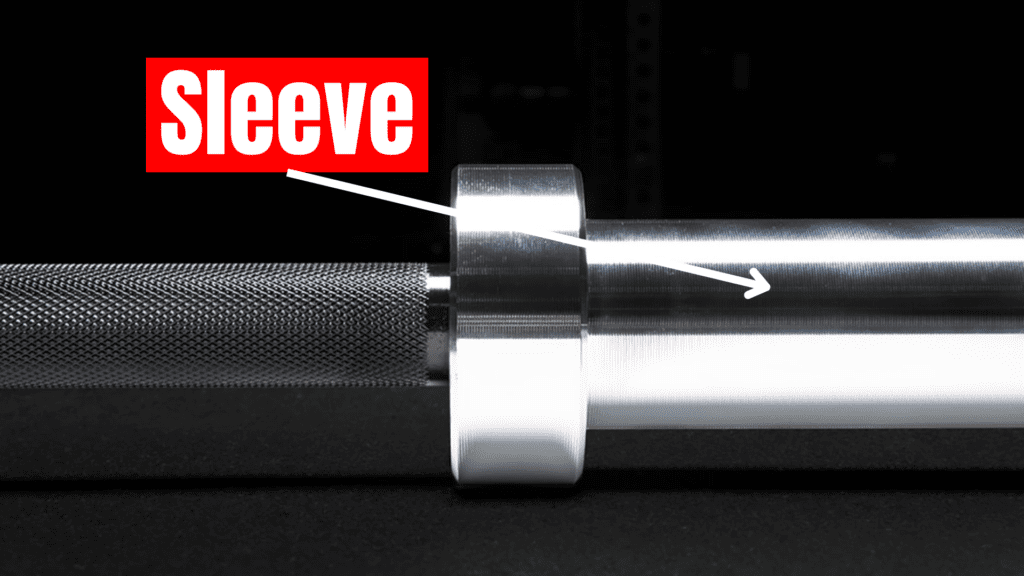
The sleeves are the cylindrical parts at either end of the barbell where you load the weight plates.
They usually have a type of rotation system or rotating mechanism with bearings or bushings.
Along with that, they can be smooth or have grooved edges to help barbell collars grip the sleeve.
Understanding the nuances can help you choose the right barbell for your needs.
Rotation Mechanism
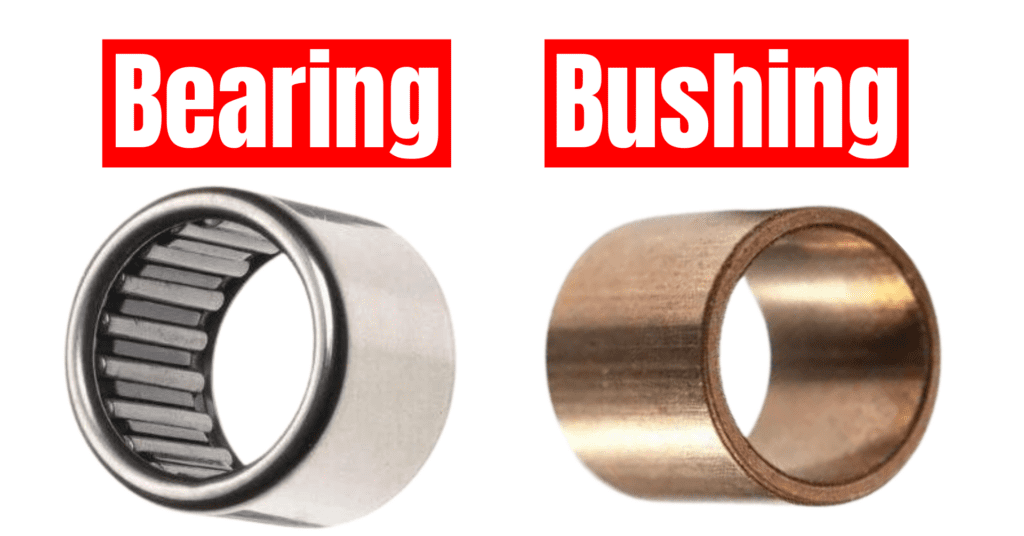
The rotation mechanism in the sleeves can significantly affect your lifting experience, especially in exercises that require the bar to rotate smoothly in your hands, like the snatch or clean and jerk.
- Bearings – These are small, needle-shaped bearings that allow for faster and smoother rotation. They’re commonly found in Olympic barbells designed for quick, dynamic lifts. Bearings are usually more expensive but offer a high level of performance.
- Bushings – These are simpler and provide a slower, more controlled rotation. They’re often found in powerlifting barbells where rapid rotation isn’t as crucial. Bushings are generally more durable and less expensive than bearings.
| Bearings | Bushings | |
|---|---|---|
| Rotation | Smooth and fast | Slower, more controlled |
| Durability | Sensitive to dust and grime, require regular maintenance | Generally more durable, require less maintenance |
| Cost | Generally more expensive | Usually less expensive |
| Best For | Olympic lifting, CrossFit, lifts requiring quick and smooth rotation | Powerlifting, general strength training, lifts requiring more control than speed |
Collar
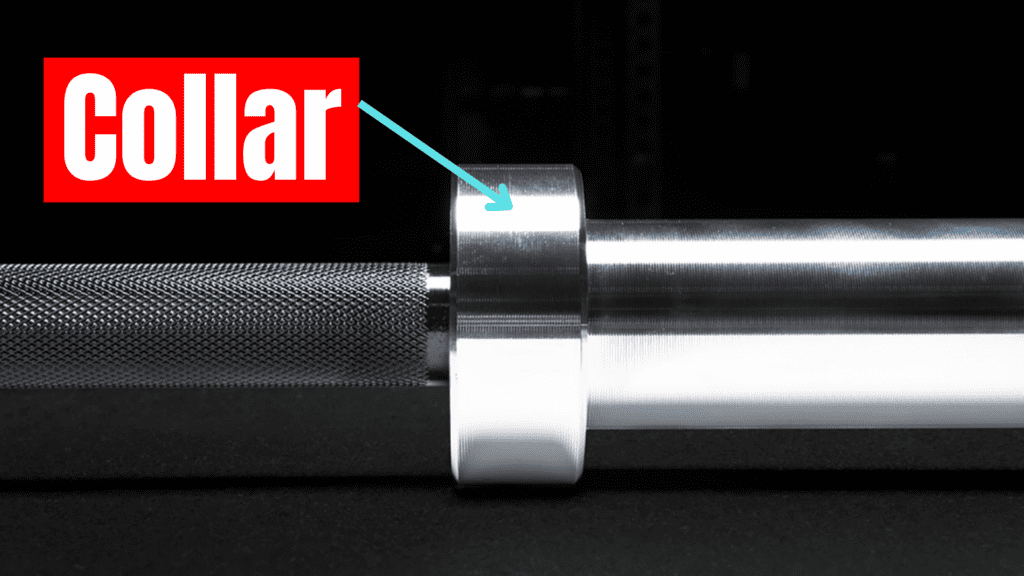
The collar on a barbell isn’t just an accessory; it serves a critical function.
Built into the barbell, this collar acts as a safeguard, preventing the weight plates from sliding inward toward the shaft.
It’s an unsung hero in your lifting routine, ensuring that your weights stay precisely where they should be during each lift.
By keeping the weights securely in place, the collar enhances both the safety and effectiveness of your workout.
End Cap

The end cap is that little disc at the end of each sleeve.
While it may seem purely decorative, it often contains valuable information about the barbell, such as the brand, model, and weight.
It’s like the barbell’s ID card.
- Branding – The end cap often features the logo or name of the manufacturer, helping you identify quality equipment.
- Specifications – Some end caps will also list the weight of the barbell, which is handy if you have multiple bars in your gym.
- Aesthetic Appeal – While not crucial, a well-designed end cap can add a touch of class to your barbell.
Knurling
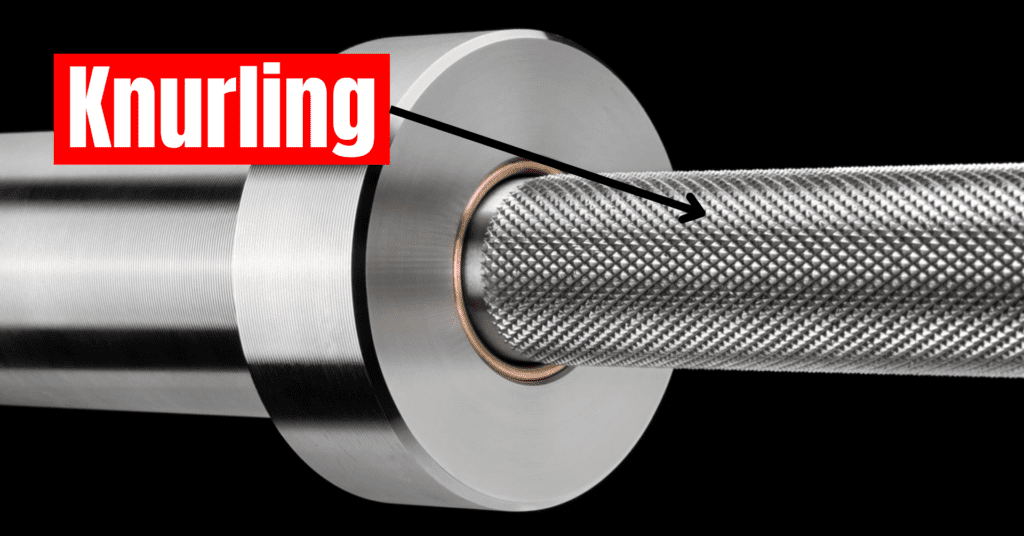
Knurling is the textured pattern etched into the shaft of the barbell. It’s not just for show; it significantly improves your grip, making it easier to hold the bar securely during lifts.
| Hill Knurling | Mountain Knurling | Volcano Knurling | |
|---|---|---|---|
| Description | Shallow, rounded peaks and valleys. Less aggressive but provides a good grip. | Sharp and deep ridges designed for maximum grip. Known for its aggressive texture. | Designed to provide a secure grip without causing discomfort or tearing of the skin. Moderately aggressive. |
| Best For | General fitness and training. | Heavy lifting, especially powerlifting. | Olympic weightlifting, powerlifting, exercises requiring a secure grip like deadlifts, cleans, and snatches. |
| Comfort Level | High: Less likely to cause skin discomfort. | Low: Can be uncomfortable or even painful for some. | Moderate: Strikes a balance between grip and comfort. |
| Commonly Found On | General fitness and training barbells. | Power bars and other bars designed for heavy lifting. | Olympic weightlifting bars and powerlifting bars. |
| Additional Notes | Ideal for high-rep sets or longer training sessions. | Depth and sharpness of the ridges can vary from bar to bar. | Provides excellent grip even when sweating profusely. |
Knurl Marks
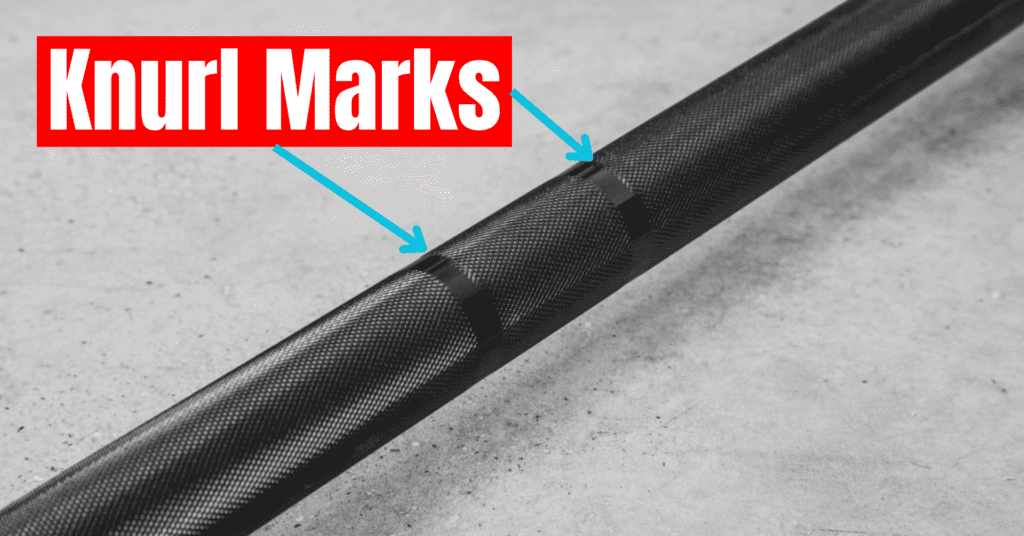
When it comes to barbell anatomy, knurl marks are more than just smooth lines on the shaft; they’re your roadmap to proper hand placement.
These strategically positioned marks guide your grip for different types of lifts, whether you’re powerlifting, Olympic weightlifting, or doing general strength training.
Understanding the significance of these marks can be a game-changer in your lifting technique, ensuring not only a better grip but also optimal performance and safety.
| Type | Description | Best For | Spacing |
|---|---|---|---|
| IPF | Found on powerlifting barbells, it’s designed to mark the maximum grip width for the bench press. | Powerlifting | Closer Spacing |
| IWF | Found on Olympic barbells, help guide hand placement for Olympic lifts like the snatch, clean, and jerk. | Olympic Lifting | Further Spacing |
| Dual Knurl | Found on multipurpose barbells, designed to accommodate a variety of lifting styles. | Multipurpose (Olympic and Powerlifting) | Variable Spacing |
Center Knurling
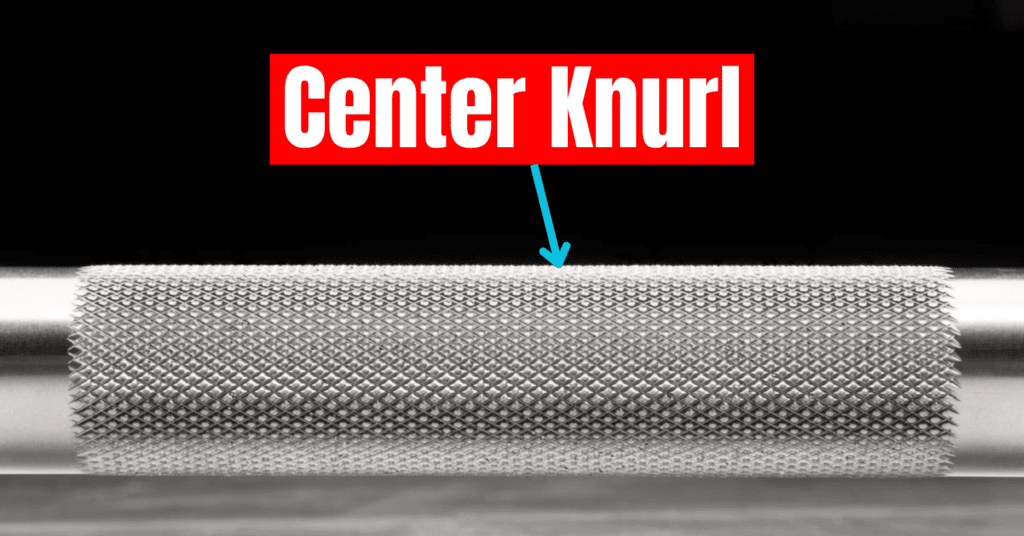
Ah, center knurling, the unsung hero of the barbell world. You might overlook it, but this little patch of texture in the middle of your bar is doing some heavy lifting—literally.
It’s all about keeping that bar snug against your back during squats or any lift where the bar’s position is critical.
- Purpose – Center knurling is often found on powerlifting barbells. It provides extra grip against your back during squats, helping to keep the bar in place.
- Texture – The center knurling is usually less aggressive than the main knurling to prevent it from being too harsh on your skin.
Dimensions and Specifications
When it comes to barbells, size does matter. The length, diameter, and weight options can significantly impact your lifting technique, comfort, and even safety.
Here’s what you need to know:
Length
- Standard Length – The standard length for men’s Olympic barbells is around 7.2 feet (2.2 meters), while women’s barbells are usually around 6.6 feet (2.01 meters).
- Specialty Bars – Some specialty bars, like squat bars or deadlift bars, may have different lengths to accommodate specific lifts.
- Home Gyms – If you’re setting up a home gym, make sure to measure your available space to ensure the barbell will fit comfortably.
Diameter
- Men’s vs. Women’s – Men’s barbells typically have a diameter of 28-29mm, while women’s barbells are usually 25mm. The diameter can affect your grip and fatigue levels during lifts.
- Powerlifting – Powerlifting barbells often have a thicker diameter between 29-32mm to provide a stiffer bar for heavy lifts. The exception is deadlift bars around 27mm.
- Olympic Lifting – Olympic barbells usually have a 28mm diameter to allow for more whip during dynamic lifts.
Weight Options
- Standard Weight – A men’s Olympic barbell usually weighs 20kg (44lbs), and a women’s Olympic barbell weighs 15kg (33lbs).
- Training Bars – These are lighter options, often weighing around 5-10kg, and are great for beginners or for practicing technique.
- Fixed Weight Barbells – These come with the weight already attached and can range from 20 to 120 pounds. They’re often used for specific exercises like curls or skull crushers.
Specialized Barbells
Not all barbells are created equal. Depending on your lifting goals, you might find that a specialized barbell is more suited to your needs.
Let’s break down the most common types:
| Bar Type | Characteristics | Best For | Unique Features |
|---|---|---|---|
| Olympic Barbells | Designed for Olympic weightlifting with bearings for smoother rotation, built to IWF standards. | Snatches, clean and jerks, and other dynamic lifts that require fast and smooth rotation. | 28mm diameter and IWF marks for hand placement. |
| Powerlifting Barbells | Built to handle massive weights, thicker diameter, and center knurling. | Squats, deadlifts, and bench presses. | 29mm diameter, built to IPF standards, more aggressive knurling. |
| Hybrid Barbells | Versatile for both Olympic lifting and powerlifting. | Those who mix up their training and don’t want to invest in multiple specialized barbells. | Usually 28.5mm in diameter, usually feature dual knurl marks. |
Maintenance and Care
Your barbell is an investment, and like any good investment, it requires regular upkeep. Here’s how to ensure your barbell stays in tip-top shape:
Cleaning and Care
- Daily Wipe-down – After each use, wipe down the barbell with a dry cloth to remove sweat and chalk. This simple act can go a long way in preventing rust.
- Weekly Cleaning – Use a mild detergent and a nylon brush to clean the knurling. Avoid using harsh chemicals that can damage the finish.
- Lubrication – Every few months, lubricate the sleeves with a light oil to ensure smooth rotation.
Longevity and Durability
- Storage – Store your barbell horizontally on a barbell rack when not in use. This prevents warping and undue stress on the bar.
- Inspection – Regularly inspect your barbell for signs of wear and tear, like chipping finish or loosening collars.
- Professional Maintenance – For high-use gym settings, consider professional maintenance services that can extend the life of your barbell.
Conclusion
Knowing your barbell’s anatomy is key to optimizing your lifts.
From rotation mechanisms like bearings or bushings to specialized knurling patterns, each feature impacts your performance and safety.
Also, make sure you realize that maintenance isn’t optional; it’s essential for the barbell’s longevity.
Whether you’re a beginner or a seasoned lifter, understanding these elements sets you up for a smarter, more effective lifting journey.
Until next time,
-Dante